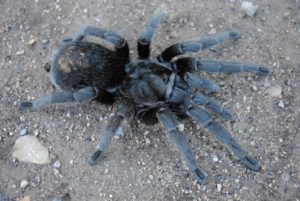Picture a stunning spider called the Uruguay black beauty tarantula. This cool creature comes straight from South America and many people love having them as pets! Curious to know more? Find out amazing facts about this spider right here!
The tarantulas lay their eggs inside a sac of silk threads.
Immature spiderlings stay with their mother, leaving her burrow when they have molted a few times.
As ambush predators, they do not use webs to catch prey.
Yes, Uruguay Black Beauty tarantulas do have venom. But here’s something interesting: their venom isn’t very strong for humans. They mostly use it to catch their meals.
They sure can! If a Uruguay Black Beauty tarantula bites, it might feel like a small poke. But for most people, it’s usually not too bothersome.

Grammostola quirogai
The Uruguay Black Beauty Tarantula plays a crucial role in maintaining the ecological balance within their habitat. As predators, they help control the population of insects, contributing to the health of their ecosystem. Their behavior is characterized by a tendency to remain hidden, emerging primarily for hunting or during the mating season.
Natural Predators and Prey-Predator Dynamics: In their natural habitat, the Uruguay Black Beauty Tarantula faces threats from larger predators, establishing a delicate prey-predator balance. This dynamic is vital for the stability of their ecosystem, ensuring that no single species dominates, and biodiversity is maintained.
Relationship with Humans: The relationship between humans and the Uruguay Black Beauty Tarantula has evolved, especially with their rising popularity in captivity. Ensuring their well-being in a domestic setting requires understanding their needs, and behavior, and providing a suitable environment that mimics their natural habitat. As with any wild species, respecting their space and acknowledging their role in nature is important.
| Lifespan | Males: 5-6 years, Females: 20-25 years |
| Distribution | Uruguay |
| Habitat | Scrublands |
| Diet | Beetles, crickets, moths |
In summary, the Uruguay Black Beauty Tarantula stands as a testament to the diversity and allure of arachnids. From their significant role in ecosystems to their intriguing physical characteristics, they offer a glimpse into the complicated world of spiders.
Image Source: arachnoboards.com, inaturalist.ca
Picture a stunning spider called the Uruguay black beauty tarantula. This cool creature comes straight from South America and many people love having them as pets! Curious to know more? Find out amazing facts about this spider right here!
The tarantulas lay their eggs inside a sac of silk threads.
Immature spiderlings stay with their mother, leaving her burrow when they have molted a few times.
As ambush predators, they do not use webs to catch prey.
Yes, Uruguay Black Beauty tarantulas do have venom. But here’s something interesting: their venom isn’t very strong for humans. They mostly use it to catch their meals.
They sure can! If a Uruguay Black Beauty tarantula bites, it might feel like a small poke. But for most people, it’s usually not too bothersome.

Grammostola quirogai
The Uruguay Black Beauty Tarantula plays a crucial role in maintaining the ecological balance within their habitat. As predators, they help control the population of insects, contributing to the health of their ecosystem. Their behavior is characterized by a tendency to remain hidden, emerging primarily for hunting or during the mating season.
Natural Predators and Prey-Predator Dynamics: In their natural habitat, the Uruguay Black Beauty Tarantula faces threats from larger predators, establishing a delicate prey-predator balance. This dynamic is vital for the stability of their ecosystem, ensuring that no single species dominates, and biodiversity is maintained.
Relationship with Humans: The relationship between humans and the Uruguay Black Beauty Tarantula has evolved, especially with their rising popularity in captivity. Ensuring their well-being in a domestic setting requires understanding their needs, and behavior, and providing a suitable environment that mimics their natural habitat. As with any wild species, respecting their space and acknowledging their role in nature is important.
| Lifespan | Males: 5-6 years, Females: 20-25 years |
| Distribution | Uruguay |
| Habitat | Scrublands |
| Diet | Beetles, crickets, moths |
In summary, the Uruguay Black Beauty Tarantula stands as a testament to the diversity and allure of arachnids. From their significant role in ecosystems to their intriguing physical characteristics, they offer a glimpse into the complicated world of spiders.
Image Source: arachnoboards.com, inaturalist.ca